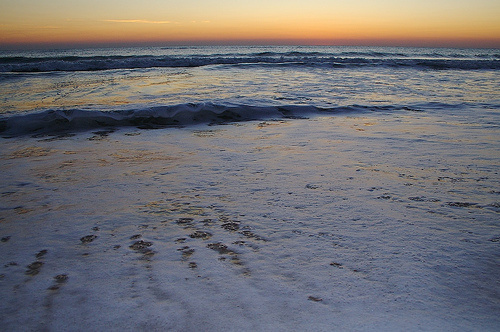A Harvard physicist has thought up a novel and very strange way of turning back global warming: pumping massive quantities of microbubbles into the oceans which would have the effect of increasing their reflectivity. By reflecting back more sunlight, the oceans will start to cool. Sound like science fiction?
Harvard physicist Russell Seitz proposed his idea at a recent geoengineering conference. The tiny bubbles essentially act as “mirrors made of air,” reflecting the sunlight and keeping oceans cool. Early simulations showed that bubbles could potentially cool the Earth by up to 3 degrees Celsius.
But don’t put your robe on just yet—there’s still plenty of obstacles before the Atlantic Ocean becomes the Atlantic Jacuzzi. The formidable task of actually getting the bubbles into the oceans is largely unexplored. Seitz has suggested deploying the bubbles with boats, pumping a mixture of water and compressed air into their wakes, but if the water has too few particles the bubbles pop before they do any reflecting.
Natural bubbles already brighten turbulent seas and provide a luster known as “undershine” below the ocean’s surface. But these bubbles only lightly brighten the planet, contributing less than one-tenth of 1% of Earth’s reflectivity, or albedo. What Seitz imagines is pumping even smaller bubbles, about one-five-hundredth of a millimeter in diameter, into the sea. Such “microbubbles” are essentially “mirrors made of air,” says Seitz, and they might be created off boats by using devices that mix water supercharged with compressed air into swirling jets of water. “I’m emulating a natural ocean phenomenon and amplifying it just by changing the physics—the ingredients remain the same.”
Computer simulations show that tiny bubbles could have a profound cooling effect. Using a model that simulates how light, water, and air interact, Seitz found that microbubbles could double the reflectivity of water at a concentration of only one part per million by volume. When Seitz plugged that data into a climate model, he found that the microbubble strategy could cool the planet by up to 3°C. He has submitted a paper on the concept he calls “Bright Water” to the journal Climatic Change.
In addition to helping curb global warming, the microbubble strategy could also help conserve water by reducing evaporation in rivers and lakes, says Seitz. That’s a problem that leads to the loss of billions of tons of freshwater each year in California alone.
Seitz says adding bubbles to a 1-square-kilometer patch of ocean is feasible, but scaling it up may be technically difficult. Energy is not the limiting factor, he says, estimating that the energy output of 1000 windmills might be sufficient to add bubbles to an entire ocean. The larger challenge to large-scale deployment, he says, would be ensuring that the bubbles last as long as possible. In nature, a bubble’s lifetime depends on the level of dissolved organic matter and nanoparticles, without which small bubbles rapidly shrink and disappear. If the water is too clean, the bubbles might not last long enough to be effectively spread over large areas, Seitz says.
One way to test the viability of the idea might be to study the impact of bubbles created in the wakes of ships, says oceanographer Peter Brewer of the Monterey Bay Aquarium Research Institute in Moss Landing, California. “It’s something nobody’s talked about,” he says of Seitz’s technique.
Source: Science.





Yes, windmills are closer to the implementation of the projects before other
Windmills are experience when starting their implementation is likely to produce electrical energy bubbles next to that limit and reduce global warming of the planet